State Emblem of India
The State Emblem of India, as the national emblem of the Republic of India is called, is an adaptation of the Lion Capital of Ashoka from 250 BCE at Sarnath, preserved in the Sarnath Museum near Varanasi. It has 4 lions that face 4 different directions, namely north, east, south, and west. A representation of the Lion Capital of Ashoka was initially adopted as the emblem of the Dominion of India in December 1947.[1] The current version of the emblem was officially adopted on 26 January 1950, the day when India became a republic.[2]
| State Emblem of India | |
|---|---|
 | |
| Armiger | Republic of India |
| Adopted | 26 January 1950 |
| Motto | Satyameva Jayate ("Truth Alone Triumphs") (from the "Mundaka Upanishad", a part of Hindu Vedas) |
History
The task of beautifying the original copy of the Constitution of India was given to Nandalal Bose (then the Principal of Kala Bhavan Shanti Niketan in Shantiniketan) by the Congress.[3][4] Bose set out to complete this task with the help of his students, one of whom was Dinanath Bhargava, then 21 years old.[5] Bose was keen to include the Lion Capital of Ashoka into the opening pages of the constitution. Wanting the lions to be depicted realistically, he chose Bhargava who studied the behavior of the lions at the Kolkata Zoo.[6] On 26 January 1950, it was adopted as the State Emblem of India.[7]
Usage and description
The emblem forms a part of the official letterhead of the Government of India and appears on all Indian currency as well. It also functions as the national emblem of India in many places and appears prominently on Indian passports. The Ashoka Chakra (wheel) on its base features in the centre of the national flag of India.
The usage of the emblem is regulated and restricted under State Emblem of India (Prohibition of Improper Use) Act, 2005 under which, no individual or private organisation is permitted to use the emblem for official correspondence.
The actual Sarnath capital features four Asiatic lions standing back to back, symbolising power, courage, confidence, and pride, mounted on a circular base. At the bottom is a horse and a bull, and at its center is a wheel (Dharma chakra). The abacus is girded with a frieze of sculptures in high relief of The Lion of the North, The Horse of the West, The Bull of the South and The Elephant of the East, separated by intervening wheels, over a lotus in full bloom, exemplifying the fountainhead of life and creative inspiration. Carved from a single block of sandstone, the polished capital is crowned by the Wheel of the Law (Dharma Chakra).
In the emblem finally adopted, only three lions are visible, the fourth being hidden from view. The wheel appears in relief in the centre of the abacus, with a bull on the right and a galloping horse on the left, and outlines of Dharma Chakras on the extreme right and left. A horse and a bull are represented right below the abacus. The bull represents hard work and steadfastness, while the horse represents loyalty, speed, and energy. The bell-shaped lotus beneath the abacus has been omitted.[8]
Forming an integral part of the emblem is the motto inscribed below the abacus in Devanagari script: Satyameva Jayate (Sanskrit: सत्यमेव जयते; lit. "Truth alone triumphs").[9] This is a quote from Mundaka Upanishad,[10] the concluding part of the sacred Hindu Vedas.
 Ashoka Stambha at Indian Museum, Calcutta
Ashoka Stambha at Indian Museum, Calcutta An early photograph of the Sarnath capital
An early photograph of the Sarnath capital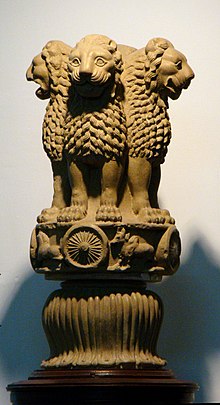 A smaller copy of the Sarnath capital at the National Museum, Delhi
A smaller copy of the Sarnath capital at the National Museum, Delhi
Emblems of national bodies
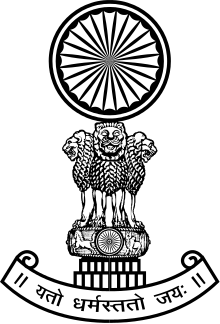 Emblem of the Supreme Court of India
Emblem of the Supreme Court of India Emblem of the Central Bureau of Investigation
Emblem of the Central Bureau of Investigation
Emblems of states and union territories
Most of the states and union territories of India have their own state emblem, seal or coat of arms which are used as an official governmental symbol, while six states and five union territories use the National Emblem of India with a text legend as their official governmental seal.
Some of the autonomous district councils established by the Sixth Schedule of the Constitution of India have also adopted an official emblem.
Historic seals and emblems
Pre-colonial India
Emblem of the Mughal Empire in historical progression
 Emblem of the Mughal Empire
Emblem of the Mughal Empire Emblem of the Mughal Empire during the reign of Aurangzeb.
Emblem of the Mughal Empire during the reign of Aurangzeb. Last known emblem of the Mughal emperor during the reign of Bahadur Shah Zafar.
Last known emblem of the Mughal emperor during the reign of Bahadur Shah Zafar.
British rule in India
 Coat of arms of the East India Company, used during the Company Raj (1757–1858)
Coat of arms of the East India Company, used during the Company Raj (1757–1858).svg.png) Coat of arms of the United Kingdom, used for official documents, publications and correspondence from the Parliament of the United Kingdom during the British Raj (1858–1947)
Coat of arms of the United Kingdom, used for official documents, publications and correspondence from the Parliament of the United Kingdom during the British Raj (1858–1947)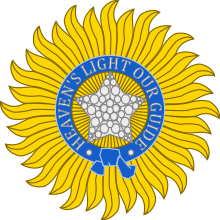 Star of India, an emblem used within India during the British Raj.
Star of India, an emblem used within India during the British Raj.
Portuguese rule in India
.svg.png) Coat of arms of Portuguese India (1600–1935)
Coat of arms of Portuguese India (1600–1935)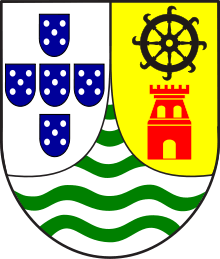 Lesser coat of arms of Portuguese India (1935–1961)
Lesser coat of arms of Portuguese India (1935–1961).svg.png) Greater coat of arms of Portuguese India (1935–1951)
Greater coat of arms of Portuguese India (1935–1951).svg.png) Greater coat of arms of Portuguese India (1951–1961)
Greater coat of arms of Portuguese India (1951–1961)
French Rule in India
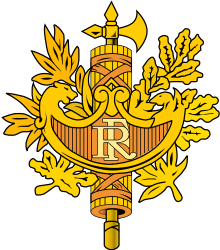 Emblem of French India (1912–1954)
Emblem of French India (1912–1954)
Azad Hind
Dominion of India
.svg.png) Coat of arms of the United Kingdom used by the Dominion of India (August–December 1947)
Coat of arms of the United Kingdom used by the Dominion of India (August–December 1947).svg.png) Emblem used by the Dominion of India (December 1947–January 1950)[1]
Emblem used by the Dominion of India (December 1947–January 1950)[1] Emblem of the Constituent Assembly of India
Emblem of the Constituent Assembly of India
See also
References
- "Press Communique' - State Emblem" (PDF). Press Information Bureau of India - Archive. Archived (PDF) from the original on 8 August 2017.
- "State Emblem". Know India. Government of India. Archived from the original on 3 March 2016. Retrieved 1 May 2016.
- "Celebrating Nandalal Bose, artist who rejected everything British & designed India's constitution". The Print.
- Pathak, Yamini (31 March 2016). "Bringing out the kala". The Hindu. ISSN 0971-751X. Retrieved 4 September 2019.
- "We Know Very Little About The Man Who Designed Our National Emblem. Here Are Some Facts Him". indiatimes.com. 26 December 2016. Retrieved 4 September 2019.
- "A Tribute to the Artist who Sketched and Illuminated India's National Emblem". The Better India. 26 December 2016. Retrieved 4 September 2019.
- "A Tribute to the Artist who Sketched and Illuminated India's National Emblem". The Better India. 26 December 2016. Retrieved 15 September 2019.
- "The State Emblem Of India (Prohibition Of Improper Use) Act, 2005" (PDF). 20 December 2005. p. 4. Archived from the original (PDF) on 19 March 2013. Retrieved 15 April 2012.
- Kamal Dey v. Union of India and State of West Bengal (Calcutta High Court 14 July 2011). Text
- "Rajya Sabha Parliamentary Standing Committee On Home Affairs: 116th Report on The State Emblem Of India (Prohibition Of Improper Use) Bill, 2004" (PDF). Archived from the original (PDF) on 8 March 2013.

